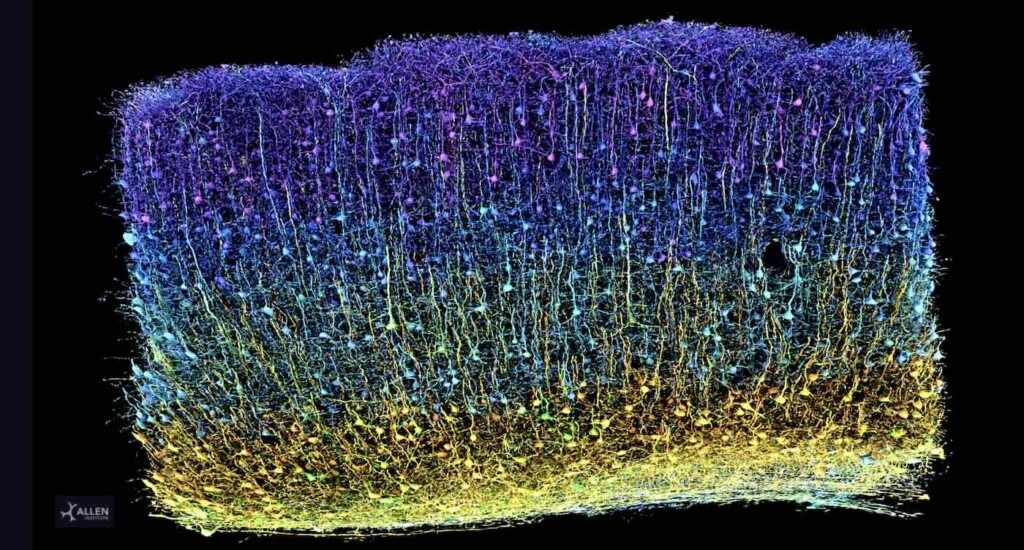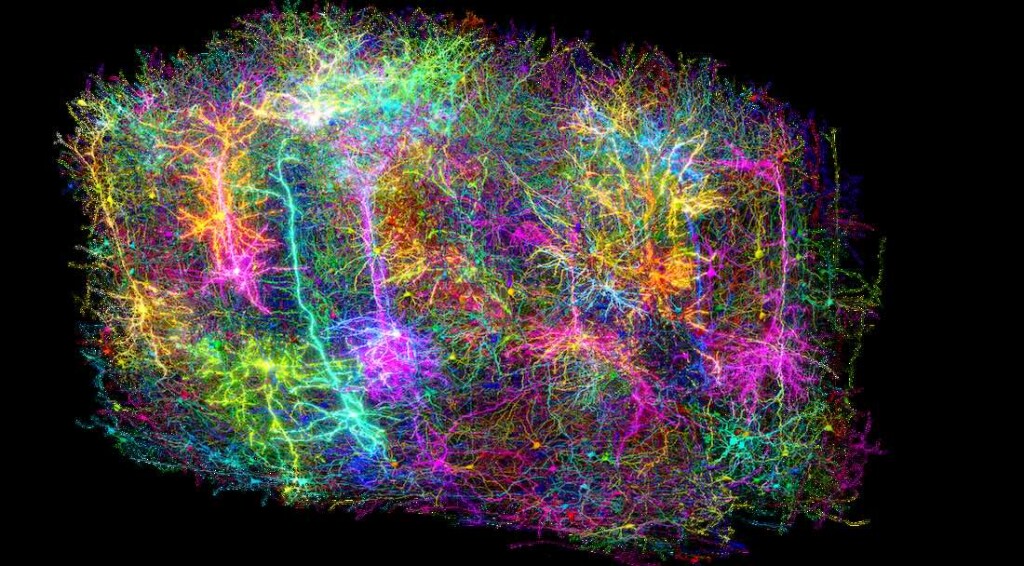
During the last seven years, a global team of more than 150 scientists collaborated on the most complicated neuroscience experiment ever attempted—and they’ve released their findings this week.
From a tiny sample of tissue no larger than a grain of sand, the MICrONS Project completed the first step toward the goal once thought unattainable: building a functional wiring diagram of a portion of the brain.
Now, they’ve published their findings in Nature with a collection of ten studies. The 3D wiring diagram and its data are massive—1.6 petabytes in size (equivalent to 22 years of non-stop HD video). They offer a never-before-seen insight into brain function and organization of the visual system.
The research started at Baylor College of Medicine where scientists used specialized microscopes to record the brain activity from a one cubic millimeter portion of a mouse’s visual cortex while the animal watched various movies and YouTube clips.
Afterwards, Allen Institute researchers took that same cubic millimeter of the brain and shaved it into more than 25,000 layers, each 1/400th the width of a human hair, and used an array of electron microscopes to take high-resolution pictures of each slice.
By the end, the MICrONS Project—Machine Intelligence from Cortical Networks—built the most detailed wiring diagram of a mammalian brain to date—and it’s freely available online.
“A watershed moment for neuroscience, comparable to the Human Genome Project” is the description from David Markowitz, Ph.D., who coordinated this work after leaving the IARPA, the US Intelligence Advanced Research Projects Activity, which partially funded it.
Another team at Princeton University used artificial intelligence and machine learning to reconstruct the cells and connections into a 3D volume. Combined with the recordings of brain activity, it contains 523 million synapses (the connection points between 200,000 cells) and a length of four kilometers of axons (the branches that reach out to other cells).

“Inside that tiny speck is an entire architecture like an exquisite forest,” said Clay Reid, Ph.D., senior investigator and one of the early founders of electron microscopy connectomics who brought this area of science to the Allen Institute 13 years ago.
“It has all sorts of rules of connections that we knew from various parts of neuroscience—and within the reconstruction itself, we can test the old theories and hope to find new things that no one has ever seen before.”
(WATCH the incredible 6 minute video below, by Tyler Sloan of Quorumetrix Studio…)
The findings from the studies reveal new cell types, characteristics, organizational and functional principles, and a new way to classify cells. Among the most surprising findings was the discovery of a new principle of inhibition within the brain.
RELATED: Light Therapy Can Help People Recover From Major Brain Injuries, Shows Study
Scientists previously thought of inhibitory cells—those that suppress neural activity—as a simple force that dampens the action of other cells. However, researchers discovered a far more sophisticated level of communication: Inhibitory cells are not random in their actions; instead, they are highly selective about which excitatory cells they target, creating a network-wide system of coordination and cooperation. Some inhibitory cells work together, suppressing multiple excitatory cells, while others are more precise, targeting only specific types.
“MICrONS will stand as a landmark where we build brain foundation models that span many levels of analysis, beginning from the behavioral level to the representational level of neural activity and even to the molecular level,” explained Andreas Tolias, Ph.D., one of the lead scientists who worked on this project at both Baylor College of Medicine and Stanford University.
Implications for brain diseases like dementia
Understanding the brain’s form and function and the ability to analyze the detailed connections between neurons at an unprecedented scale opens new possibilities for studying the brain and intelligence. It also has implications for disorders like Alzheimer’s, Parkinson’s, autism, and schizophrenia involving disruptions in neural communication.
“If you have a broken radio and you have the circuit diagram, you’ll be in a better position to fix it.” said Nuno da Costa, Ph.D., associate investigator at the Allen Institute. “We are describing a kind of Google map or blueprint of this grain of sand. In the future, we can use this to compare the brain wiring in a healthy mouse to the brain wiring in a model of disease.”
AMAZING: Short-Term Memory Can Be Improved With Non-Invasive Laser Light Therapy Pointed at Human Brains
The multi-institution collaboration, which included Harvard scientists, was made possible by support from the IARPA and US National Institutes of Health’s BRAIN Initiative.
“Basic science building blocks—like how the brain is wired—are the foundation we need to better understand brain injury and disease, to bring treatments and cures closer to clinical use.”
“IARPA’s moonshot investment in the MICrONS program has shattered previous technological limitations, creating the first platform to study the relationship between neural structure and function at scales necessary to understand intelligence… and sets the stage for future scaling to the whole brain level,” adds IARPA’s Markowitz.
In 1979, famed molecular biologist Francis Crick stated that it would be “impossible to create an exact wiring diagram for a cubic millimeter of brain tissue and the way all its neurons are firing,” which inspired Allen Institute’s Senior Investigator Clay Reid to pursue the subject as his life’s work.
CHECK OUT MORE GOOD NEWS IN THE BRAIN AT GNN
This map of neuronal connectivity, form, and function from a grain of sand-sized portion of the brain is not just a scientific marvel, but a step toward understanding the elusive origins of thought, emotion, and consciousness—and the “impossible” task first envisioned by Crick is now one step closer to reality.
TELEPORT THE AWE-INSPIRING NEWS By Sharing On Social Media…




















